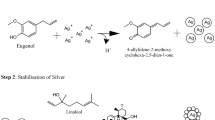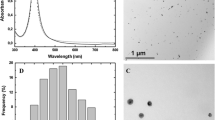Abstract
Microbial contamination in wounds leading to severe sepsis can be treated by silver-based antiseptics. However, frequent application of silver-based antiseptics, staining of skin, burning, and irritation at application site resulted to poor patient compliances. Thus, we formulated sericin- and chitosan-capped silver nanoparticle (S/C-SNP)-loaded hydrogel for accelerated wound healing and antimicrobial properties. The wound healing property of sericin, antibacterial nature of chitosan and silver, and mucoadhesive property of carbopol were utilized in development of novel wound dressing hydrogel to investigate the combined effect of these materials for effective treatment of wounds. The chemical reduction method was successfully employed for the synthesis of SNPs using sericin and chitosan as a capping/reducing agent. The SNPs were characterized by ultraviolet-spectroscopy (UV–Vis), Fourier transform infrared spectroscopy (FTIR), dynamic light scattering (DLS), and transmission electron microscopy (TEM). The optimized SNPs were further used for preparation of carbopol hydrogel (0.5, 0.75, and 1.0 % w/v). The prepared hydrogels were characterized for pH, viscosity, and texture analysis. The antimicrobial activity and wound healing activity of the optimized hydrogel (S/C-SNPs G-1) demonstrated higher bactericidal activity and wound closure, as supported by results of histopathology. Hydrogel containing capped SNPs has application in wound healing treatment.






Similar content being viewed by others

References
Clark R. The molecular and cellular biology of wound repair. 2nd ed. New York; 1996.
Akturk O, Tezcaner A, Bilgili H, Deveci MS, Gecit MR, Keskin D. Evaluation of sericin/collagen membranes as prospective wound dressing biomaterial. J Biosci Bioeng. 2011;112:279–88.
Sai KP, Babu M. Collagen based dressings-a review. Burns. 2000;26:54–62.
Pei HN, Chen XG, Li Y, Zhou HY. Characterization and ornidazole release in vitro of a novel composite film prepared with chitosan/poly(vinyl alcohol)/alginate. J Biomed Mater Res A. 2004;85:566–72.
Kokabi M, Sirousazar M, Hassan ZM. PVA–clay nanocomposite hydrogels for wound dressing. Eur Polym J. 2007;43:773–81.
Singh B, Sharma S, Dhiman A. Design of antibiotic containing hydrogel wound dressings: biomedical properties and histological study of wound healing. Int J Pharm. 2013;457:82–91.
Higa OZ, Rogero SO, Machado LDB, Mathor MB, Lugao AB. Biocompatibility study for PVP wound dressing obtained in different conditions. Radiat Phys Chem. 1999;55:705–7.
Syed KH. Gulrez SA. Glyn OP. Hydrogels: methods of preparation, characterisation and applications. Prog Mol Environ Bioeng. 2011.
Moody A. Use of a hydrogel dressing for management of a painful leg ulcer. Wound Care. 2006;12–17.
Fox CL, Modak SM, Stanford JW. Zinc sulfadiazine for topical therapy of pseudomonas infection in burns. Surg Gynecol Obstet. 1976;142:553–9.
Robson MC. Wound infection: a failure of wound healing caused by an imbalance of bacteria. Surg Clin North Am. 1997;77:637–50.
Poston J. Sharp debridement of devitalized tissue: the nurse’s role. Br J Nurs. 1996;5:65–2.
Kim JS, Kuk E, Kuk KN, Kim JH, Park SJ, Lee HJ. Antimicrobial effects of silver nanoparticles. Nanomed Nanotechnol Biol Med. 2007;3:95–101.
Lara HH, Ayala NV, Turrent LDCI, Padilla CR. Bactericidal effect of silver nanoparticles against multidrug-resistant bacteria. World J Microbiol Biotechnol. 2010;26:615–21.
Mishra M, Kumar H, Tripathi K. Diabetic delayed wound healing and the role of silver nanoparticles. Dig J Nanomater Bios. 2008;3:49–54.
Klein DG, Fritsch DE, Amin SG. Wound infection following trauma and burn injuries. Crit Care Nurs Clin North Am. 1995;7:627–42.
Zain NM, Stapley AGF, Shama G. Green synthesis of silver and copper nanoparticles using ascorbic acid and chitosan for antimicrobial applications. Carbohydr Polym. 2014;112:195–202.
Tian J, Wong KKY, Ho C-M, Lok C-N, Yu W-Y, Che C-M. Topical delivery of silver nanoparticles promotes wound healing. Chem Med Chem. 2007;2:129–36.
Thawatehai M, Seiichi T, Ratana R. Impregnation of silver nanoparticles into bacterial cellulose for antimicrobial wound dressing. Carbohydr Polym. 2008;72:43–51.
Majid D, Din AM, Halim AA, Azowa IN. Green synthesis and characterization of gelatin based and sugar-reduced silver nanoparticle. Int J Nanomedicine. 2011;6:569–74.
Mandal A, Sastry TP. Fabrication of gelatin based composites containing bimetallic Ag-Au nanoparticles for biomedical application. Int J Innov Res Sci Eng Tech. 2014;3:12463–73.
Khanna PK, Singh N, Charan S, Subbarao UVVS, Gokhale R, Mulik UP. Synthesis and characterization of Ag/PVA nanocomposite by chemical reduction method. Mater Chem Phys. 2005;93:117–21.
An HK, Loon CK. Aggregation kinetics of citrate and PVP coated silver nanoparticles in monovalent and divalent electrolyte solution. Environ Sci Technol. 2011;45:5564–71.
Mila T, Isabella R, Ruth MC, Jamie LR. Stability of citrate, PVP and PEG coated silver nanoparticles in ecotoxicology media. Environ Sci Technol. 2012;46:7011–7.
Atta AM, Lohedan HAA, Ezzat AO. Synthesis of silver nanoparticles by green method stabilized to synthetic human stomach fluid. Molecules. 2014;19:6737–53.
Kumar PK, Rabinal MK, Kalasad MN, Sankarappa T, Bedre MD. Chitosan capped silver nanoparticles used as pressure sensors. J Appl Phys. 2014;5:43–51.
Goudarzi EHM. Electro-spinning of chitosan/sericin/PVA nanoparticles incorporated insitu synthesis of nanosilver. Carbohydr Polym. 2014;113:231–9.
Bhat PN, Nivedita S, Roy S. Use of Bombyx mori in the synthesis of silver nanoparticle, their characterization and application. Ind J Fib Tex Res. 2011;36:168–71.
Pornanong A, Nipaporn B, Juthamas R, Sanong E. Green synthesis of silk sericin-capped silver nanoparticles and their potent anti-bacterial activity. Nanoscale Res Lett. 2014;17:276–9.
Dongwei W, Wuyong S, Weiping Q, Yongzhong Y, Xiaoyuan M. The synthesis of chitosan-based silver nanoparticles and their antibacterial activity. Carbohydr Res. 2009;344:2375–82.
Sanpui P, Murugadoss A, Prasad PVD, Ghosh SS, Chattopadhyay A. The antibacterial properties of a novel chitosan–Ag-nanoparticle composite. Int J Food Microbiol. 2008;124:142–6.
Pornanong A, Sorada K, Phaibul P, Teerapol S. Effectiveness of inflammatory cytokines induced by sericin compared to sericin in combination with silver sulfadiazine cream on wound healing. Wounds. 2009;21:198–206.
Khire TS, Kundu J, Kundu SC. The fractal self- assembly of silk protein sericin. Soft Matter. 2010;6:2066–71.
Wu J, Wanng Z, Xu S. Preparation and characterization of sericin powder extracted from silk industry wastewater. Food Chem. 2007;103:1255–62.
Ravi Kumar MNV. A review of chitin and chitosan applications. J. React Funct Polym. 2000;46:1–27.
Abdelrahman MA, Samuel MH, Orlando JR. Antimicrobial wound dressing nanofiber mats from multicomponent (chitosan/silver-NPs/polyvinyl alcohol) systems. Carbohydr Polym. 2014;100:166–78.
Riccardo AAM. Chitins and chitosans for the repair of wounded skin, nerve, cartilage and bone. Carbohydr Polym. 2009;76:167–82.
Tang C, Yin L, Yu J, Yin C, Pei Y. Swelling behavior and biocompatibility of carbopol-containing superporous hydrogel composites. J Appl Polym Sci. 2007;104:2785–91.
Proniuk S, Blanchard J. Anhydrous carbopol polymer gels for the topical delivery of oxygen/water sensitive compounds. Pharm Dev Technol. 2002;7:249–55.
Liqun Y, Kaicheng L, Rongchun S, Lin MA, Liming Z, Kang LU. Silver nanoparticles based antibacterial hydrogels. Acta Sci Nat Univ Sunyatseni. 2011;50:58–61.
Arellano A, Santoyo S, Martín C, Ygartua P. Influence of propylene glycol and isopropyl myristate on the in vitro percutaneous penetration of diclofenac sodium from carbopol gels. Eur J Pharm Sci. 1999;7:129–35.
Laemmli UK. Cleavage of structural proteins during the assembly of the head of bacteriophage T4. Nature. 1970;227:680–5.
Samano-Valencia C, Martínez-Castanon GA, Martínez-Martínez RE, Loyola-Rodríguez JP, Reyes-Macías JF, Ortega-Zarzosa G, Niño-Martínez N. Bactericide efficiency of a combination of chitosan gel with silver nanoparticles. Mater Lett. 2013;106:413–6.
Mohamad N, Amin MCIM, Pandey M, Ahmad N, Rajab NF. Bacterial cellulose/acrylic acid hydrogel synthesized via electron beam irradiation: accelerated burn wound healing in an animal model. Carbohydr Polym. 2014;114:312–20.
Aramwit P, Siritientong T, Srichana T. Potential applications of silk sericin, a natural protein from textile industry by-products. Waste Manag Res. 2012;30:217–24.
Lamboni L, Gauthier M, Yang G, Wang Q. Silk sericin: a versatile material for tissue engineering and drug delivery. Biotechnol Adv. 2015;33:1855–67.
Anghileri A, Lantto R, Kruus K, Arosio C, Freddi G. Tyrosinase-catalyzed grafting of sericin peptides onto chitosan and production of protein–polysaccharide bioconjugates. J Biotechnol. 2007;127:508–19.
Nishida A, Yamada M, Kanazawa T, Takashima Y, Ouchi K, Okada H. Sustained-release of protein from biodegradable sericin film, gel and sponge. Int J Pharm. 2011;407:44–52.
Zhang YQ, Tao ML, Shen WD, Zhou YZ, Ding Y, Ma Y, Zhou WL. Immobilization of l-asparaginase on the microparticles of the natural silk sericin protein and its characters. Biomaterials. 2004;25:3751–9.
Umadevi M, Bindhu MR, Sathe VA. Novel synthesis of malic acid capped silver nanoparticles using Solanum lycopersicums fruit extract. J Mater Sci Technol. 2013;29:317–22.
Goudarzi EH, Montazer M, Latifi M, Aghaji AAG. Electrospinning of chitosan/sericin/PVA nanofibers incorporated with in situ synthesis of nano silver. Carbohydr Polym. 2014;113:231–9.
Srihanam P, Simcheur W, Srisuwan Y. Study on silk sericin and chitosan blend film: morphology and secondary structure characterizations. J Biol Sci. 2009;12:1487–90.
Jana S, Manna S, Nayak AK, Sen KK, Basu SK. Carbopol gel containing chitosan-egg albumin nanoparticles for transdermal aceclofenac delivery. Colloids Surf B: Biointerfaces. 2014;114:36–44.
Kanoujia J, Sonker K, Pandey M, Kymonil KM, Saraf SA. Formulation and characterization of a novel pH-triggered in-situ gelling ocular system containing Gatifloxacin. Int Curr Pharm J. 2012;1:43–9.
Rai VK, Yadav NP, Sinha P, Mishra N, Luqman S, Dwivedi H. Development of cellulosic polymer based gel of novel ternary mixture of miconazole nitrate for buccal delivery. Carbohydr Polym. 2014;103:126–33.
Shi L, Yang L, Zhang H, Chen L, Tao L, Wei Y, Liu H, Luo Y. A novel poly(γ-glutamic acid)/silk-sericin hydrogel for wound dressing: synthesis, characterization and biological evaluation. Mater Sci Eng C. 2015;48:533–40.
Rabea EI. Chitosan as antimicrobial agent: applications and mode of action. Biomacromolecules. 2003;4:1457–65.
Acknowledgments
The authors thank Department of Applied Animal Science, BBA University, Lucknow, India for providing cocoons of Bombyx mori.
Author information
Authors and Affiliations
Corresponding author
Ethics declarations
The animal experiments were performed with the approval of Institutional Animal Ethical Committee (registration number SDCOP&VS/AH/CPCSEA/01/0026).
Conflict of interest
The authors declare that they have no conflict of interest.
Additional information
Jyoti Verma and Jovita Kanoujia have equally contributed in doing the benchwork.
Electronic supplementary material
ESM 1
(DOCX 114 kb)
Rights and permissions
About this article
Cite this article
Verma, J., Kanoujia, J., Parashar, P. et al. Wound healing applications of sericin/chitosan-capped silver nanoparticles incorporated hydrogel. Drug Deliv. and Transl. Res. 7, 77–88 (2017). https://doi.org/10.1007/s13346-016-0322-y
Published:
Issue Date:
DOI: https://doi.org/10.1007/s13346-016-0322-y



